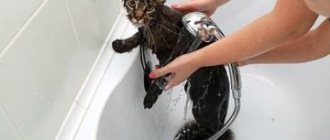The Ultrasound examination procedure is the most popular method for examining internal organs in cats and cats, which is used to make a diagnosis.
Using ultrasound, you can see the structural condition of internal organs.
Using ultrasound, a veterinarian can identify various pathological processes in organs. Ultrasound determines the size, shape, and structure of organs. You can also detect various neoplasms, fluid in the abdominal cavity, cysts and stones in the kidneys, bladder, and gall bladder.
An ultrasound is necessary when a cat is pregnant. You can determine the period and number of fruits.
How are ultrasounds performed on cats?
Ultrasound is performed after certain preparatory measures:
- Fasting diet (preferably 12 hours)
- For flatulence - avoid gas-forming products, take carminatives
- Bowel emptying
- Examination of the thoracic cavity and pelvic organs does not require additional preparation.
Ultrasounds for cats and kittens can be done at home. Modern equipment allows this. Conducting the test at home will reduce stress in your pet. Since the animal will be calm, the results of the study will be most accurate.
Can you do an ultrasound at home?
If for some reason a visit to the hospital is not possible, you can carry out diagnostics at home by pre-ordering the appropriate service.
This method has its advantages and disadvantages. It is important to consider that there are many factors at home that can influence the results of the study. Therefore, it is not always possible to accurately determine whether a cat’s health is normal or if there are abnormalities. In emergency situations, it is recommended to take the animal to a clinic that is open 24 hours a day. Diagnostic services, including ultrasound, are provided by the Zoovet veterinary clinic, whose specialists will help you quickly and accurately establish a diagnosis and prescribe adequate treatment.
Cost of ultrasound for a cat
| Name of veterinary services | Unit | Price, rub |
| Ultrasound 1 | the entire abdominal cavity | 1500 |
| Ultrasound 2 | 1 area | 600 |
| Ultrasound 3 | 1 organ system | 800 |
| Bone examination 1 | 1 sightseeing | 1000 |
| Bone examination 2 | 1 area | 600 |
| Otoscopy | 1 research | 200 |
| Ophthalmoscopy | 1 research | 200 |
| ECG (Electrocardiography) | 1 research | 1000 |
| ECHO of the heart | 1 research | from 1000 |
| Tonometry of the eye | 1 animal | 500 |
| X-ray | 1 area | 1000 |
CLINIC REGISTRATION
HOME CALL
A reliable result depends not only on high-quality equipment, but also on the competence of the doctor. Our doctors are constantly developing in their field.
When is it necessary to do an ultrasound of the heart of a cat and dog?
First of all, such a procedure is necessary for preventive purposes - the earlier the disease is detected, the higher the chance of successful treatment. If you suspect that your pet is unwell, contact your veterinarian as soon as possible. A urine and blood test cannot give a full clinical picture, and therefore the doctor often prescribes an echo kg; we recommend listening to the advice of a specialist and doing everything he says.
A dog's heart ultrasound should be performed for preventive purposes on all older dogs (once every six months), during pregnancy, before sterilization and mating, as well as after injuries and illnesses, in order to determine possible complications. Scanning is also recommended in the following cases:
- murmurs were detected during auscultation of the heart and lungs;
- chronic kidney and liver diseases;
- before surgery, if the use of anesthesia is implied;
- shortness of breath and cough appeared;
- the pet's activity has decreased;
- swelling of the paws;
- cyanosis on the tongue and in the oral cavity;
- poor appetite or the pet refuses food altogether.
Features of ultrasound for cats:
Ultrasound for cats is an important procedure that can provide answers to many diagnostic questions. In our clinic, we perform an ultrasound examination of the cat to assess the condition of the internal organs. Using this procedure, you can see changes not only in the abdominal cavity, but also assess the performance of the heart and reproductive system of organs.
Sometimes the study is supplemented with radiographic information for a more complete picture of the course of the disease.
Typically, the abdominal cavity is examined using ultrasound. In this case, the veterinarian has the opportunity to check how the organs of the liver, kidneys and bladder, spleen, and reproductive systems work. The doctor evaluates the shape of the organs, their size and internal structure, and correct location.
Ultrasound examination reveals:
- existing tumors,
- inflamed lymph nodes,
- ascites.
With an ultrasound of the bladder, on the contrary, the organ should be full, so you should try to ensure that the cat does not go to the toilet for several hours before the appointment. Each organ examined has its own nuances, which the veterinarians at our Bio-Vet clinic will certainly warn you about.
It is also important to prepare the surface of the part of the body with which the ultrasound sensor will come into contact: before the procedure, the area to be examined will need to be shaved.
Ultrasound examinations of cats are carried out in exactly the same way as dogs and, indeed, all other animals. All recommendations on nutrition and toileting schedule before the procedure will also be provided to you by the veterinary specialists of our clinic, and the area of the cat’s body that will need to be prepared for examination will be shaved before the examination. The latter is one of the main things in preparation, because if this is not done, then the ultrasound examination simply will not show anything.
Preparing animals for ultrasound examination
Ultrasound of the digestive system
- the most common test performed in clinical practice, since most animals visiting the clinic show some signs of digestive disorders. This can include vomiting of varying intensity and frequency, diarrhea, blood in the stool, and refusal to feed in very severe cases.
What organs are being examined?
First of all, the ultrasound plan includes the digestive tract: the stomach, small intestine, and large intestine. In addition, the liver and gallbladder are most often included in the study, as well as the pancreas and abdominal lymph nodes.
How to prepare an animal for an ultrasound and is preparation really that necessary?
The main strong recommendation is a fasting diet for 10-12 hours, no less. Even “just a little food a couple of hours ago” can greatly distort the sonography data, and the visual diagnostic doctor will be forced to ask the owner to bring the pet again after the diet. Why such strictness? The thing is that the norms for wall thickness and the level of peristaltic activity, on the measurement of which the assessment of the gastrointestinal tract organs is based, are described specifically for hungry animals. For example, the doctor knows that after 10-12 hours of a fasting diet, there should be no liquid or solid inclusions in the stomach, only a moderate amount of gas is allowed. It happens that animals, when experiencing stress, are able to “inhale” their stomach, that is, there will be a lot of gas, a certain “discount” is made for this. In the small intestine of a hungry dog or cat there is almost no content; single wave-like (peristaltic) movements of the intestines are permissible, which is understandable: since there is no food, the intestines do not work. Sometimes very impressionable cats may experience spasms of the duodenum and nothing more. In the large intestine, feces are usually clearly visible (you can determine their density and the size of the intestinal lumen, which is important in the diagnosis of coprostasis) and gas. The frequency of meals rarely affects the contents of the large intestine, so a fasting diet is usually not required for its study. However, it is not often possible to rely solely on visualization of the colon to make a diagnosis. A well-fed animal’s stomach may contain a mass of heterogeneous inclusions, and distinguishing food from foreign bodies, especially small ones, can be difficult, and sometimes even impossible. The visual diagnostic doctor must eliminate errors as much as possible and increase the reliability of the study, which obliges him to repeat the study over time after some time (usually within 24 hours) if there are any doubts. After feeding, the thickness of the walls of the stomach and intestines increases due to increased blood flow, so the body prepares to process incoming food. Are the walls really thickened due to inflammation? Or is it digestion? The doctor must make the right conclusion in order to prescribe adequate therapy (or not prescribe if it is not necessary), so again a repeat study must be carried out after the diet. In addition, after feeding, the peristaltic activity of the organs of the gastrointestinal tract is activated: the stomach constantly contracts, mixing food inside itself and pushing it into the intestines; in the loops of the small intestine, single contractions are replaced by constant various movements, chyme moves rapidly, not always evenly and unidirectional. And again the questions: the intestines move violently and unevenly and during inflammatory processes, so how to distinguish one from the other? Only the picture of the large intestine remains almost unchanged, except for the fact that it is partially (sometimes significantly!) hidden by the actively moving contents of the small intestine. There are also peculiarities in the visualization of the gallbladder: in a hungry animal it is full, in a well-fed animal it is very empty and, sometimes, difficult to recognize. The walls of an empty gallbladder look thicker than they actually are. How to exclude cholecystitis, in which the walls also thicken? Again, dynamic research is needed. There is no ambiguity here: only a fasting diet of 10-12 hours, and the reliability of the examination of the gastrointestinal tract and gall bladder will be maximum.
Does the rule apply to everyone?
And there are exceptions to this rule: in small (up to 6-7 months) puppies and kittens, the level of glucose in the body is maintained very poorly and strongly depends on the time of feeding. It is simply impossible not to feed them for 12 hours, maximum 5-6 hours. In these cases, the ultrasound doctor has to rely solely on his own knowledge and experience.
Can I get something to drink?
If there is fluid in the stomach, then the visual diagnostic doctor has a choice of 2 main options: it is water, since the animal was given something to drink less than 2 hours ago, or it is reflux (in other words, vomit) that has accumulated due to inflammation in the stomach and a violation of its evacuation contents into the intestines. Therefore, it is optimal to remove the bowl of water from the animal 4-5 hours before the study. There are situations when, in doubtful cases, the doctor himself asks to give the animal something to drink at the appointment. That is, the ultrasound picture of the empty gastrointestinal tract is first assessed, and then again, after drinking. This way you can determine the patency of the junction from the stomach to the intestines (pilus) and better examine foreign bodies in the stomach, but here the doctor clearly understands what the picture was like before drinking and how much water was introduced into the stomach. There were cases when such tactics made it possible to determine the partial patency of the pylorus: a foreign body stood “in space”, allowing water to pass through, but causing obstruction of even porridge-like food masses. To miss such a situation would mean dooming the animal to painful death.
What else do you need?
A significant number of visual diagnostic doctors insist not only on a starvation diet before performing an ultrasound, but also on giving the animal anti-flatulence drugs, for example Espumisan, since gases in the intestines can “hide” objects located further from the sensor, which reduces the diagnostic value and reliability of the study . Therefore, before you sign up for an ultrasound, try to clarify the preparation requirements at the clinic. Ultrasound is a very informative method for examining the organs of the gastrointestinal tract, however, to obtain the most reliable results, you must follow the rules for preparing the animal. In this case, the likelihood of errors is minimized and the accuracy of the study is increased, and the possibility that the animal will have to be brought in for the same ultrasound again the next day is reduced.
We wish your pets health!
Veterinary doctor for visual diagnostics of the Medical Center "Medvet", Domodedovo branch, Ph.D., PhD, Korneeva Anna Vladimirovna
Preparation
An abdominal ultrasound is one of those types of examinations for which you need to prepare. This preparation is necessary and includes, for example, a certain diet and a number of other measures: all rules play an important role in the informativeness of the study. Before an abdominal ultrasound, important requirements and recommendations must be observed.
Three days before ultrasound
3 days before the scheduled procedure, you need to change your diet and switch to split meals: eat small portions every 3 hours. Be sure to drink water or tea about 1.5 liters per day. What should you not eat before the test? Completely exclude from the menu products that enhance gas formation processes. Which? These are, first of all, yeast-containing products, fruits, peas and beans, soda, fatty protein dishes, alcoholic drinks, milk, juices, cabbage and grapes.
What can you eat before an abdominal ultrasound? Boiled, baked or steamed vegetables, cereals, and soups are allowed for consumption. Lean meat, lean fish, light cheese, boiled egg are allowed, no more than 1 per day. If there is a tendency to increased gas formation, it is better to drink adsorbents (“Espumizan”, “Simethicone”, “Enterosgel”, activated carbon: how to take them can be found in the instructions for the drugs).
To prevent flatulence, the doctor may recommend enzyme preparations: “Festal”, “Mezim” or “Pancreatin”.
Evening before the test
How long do you not eat before the ultrasound? A light dinner on the eve of the examination should be completed before 20.00. You should not include fish and meat dishes, even low-fat ones. If the patient is prone to constipation, a single use of a laxative is recommended (take Senade, Fitolax, Microlax, Fortrans and others). If laxatives are ineffective, the day before the ultrasound the patient is prescribed a cleansing enema.
Day of procedure
If an ultrasound is performed in the morning, it is better to do it on an empty stomach. If the procedure is planned in the afternoon, then breakfast should be light and should be completed before 11.00. A couple of hours before the planned test, you need to take Simethicone (or Espumisan) emulsion or 2 capsules of the drug. You can replace it with 6-10 carbon tablets or Filtrum. In the morning before the procedure, an additional enema may be needed if a tendency to flatulence has already been noted.
What to replace the medicine with?
Before an ultrasound of the peritoneal organs, adults can replace Espumisan with not only activated charcoal, but also other drugs:
- Filtrum;
- Metsil Forte;
- Sub Simplex;
- Festal;
- Mezim;
- Enterosgel;
- Smecta.
If there are problems with the function of the digestive tract, it is necessary to take symptomatic therapy medications in the evening. For constipation, take a laxative orally or rectally in the form of a suppository. Do not take binding medications.
If the patient does not comply with the doctor’s requests and move during the examination, the results may be distorted. The specialist will ask you to hold your breath, take a deep breath or turn on your side - this is necessary to examine all organs: kidneys, liver, stomach, gallbladder, intestines, pancreas.
Everyone should remember that before an ultrasound examination (ultrasound), certain rules must be followed, without which the examination will be inaccurate or fail.
We will list the basic rules for preparing for the most common studies.
Indications and purposes
The veterinarian prescribes ultrasound for cats in cases where other methods are not very informative. In addition, this is one of the few possibilities for home diagnostics - modern hardware equipment in veterinary clinics allows you to perform an ultrasound on a cat at home, eliminating the consequences of transportation and stress.
Indications for diagnosis are the following symptoms:
- Frequent attacks of vomiting;
- Severe diarrhea;
- Breathing problems - increased frequency, difficulty breathing;
- Impurities and blood clots in the stool;
- Change in urine color;
- General lethargy.
Appointment for such an examination is advisable in case of high temperature, prolonged refusal to eat food, or unsteady gait.
Ultrasound diagnostics during pregnancy
Routine ultrasound diagnostics are carried out during pregnancy. Immediately after mating, an ultrasound examination is carried out no earlier than 21 days later. Already in this period, the fact of fertilization can be detected.
Later, when pregnancy is confirmed, the examination is carried out 2-3 more times to determine the number of fetuses, their presentation in the uterus, possible pathologies and to monitor the course of pregnancy.
Two owners are better than one
If possible, try to take another family member with you to perform an ultrasound on your pet, so that the two of you can better fix the animal on the table. The quality of the procedure depends on the quality of fixation. In veterinary clinics, as a rule, there are always assistants and other employees who can help hold the animal, but some dogs and cats react excitedly to strangers and behave more calmly with their owners.
Senatorov Nikita, Veterinary Center for Animal Health and Rehabilitation “Zoostatus”
Blog article Blog article on LiveJournal Blog article on Facebook You can download the article in pdf, epub or doc format here











